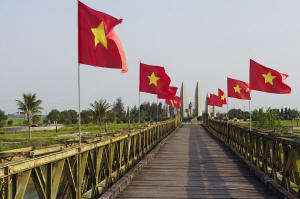50 years later, Vietnam's battlefields draw retrospective veterans and
other tourists
[April 10, 2025]
By DAVID RISING and HAU DINH
HO CHI MINH CITY, Vietnam (AP) — Hamburger Hill, Hue, the Ia Drang
Valley, Khe Sanh: Some remember the Vietnam War battles from the
headlines of the 1960s and 1970s, others from movies and history books.
And thousands of Americans and Vietnamese know them as the graveyards of
loved ones who died fighting more than a half-century ago.
Today the battlefields of Vietnam are sites of pilgrimage for veterans
from both sides who fought there, and tourists wanting to see firsthand
where the war was waged.
“It was a war zone when I was here before,” reflected U.S. Army veteran
Paul Hazelton as he walked with his wife through the grounds of the War
Remnants Museum in Ho Chi Minh City, which was known as Saigon when he
served there.
Hazelton’s tour just shy of his 80th birthday took him back for the
first time to places he served as a young draftee, including Hue, the
former Phu Bai Combat Base on the city's outskirts, and Da Nang, which
was a major base for both American and South Vietnamese forces.
“Everywhere you went, you know, it was occupied territory with our
military, now you just see the hustle and bustle and the industry, and
it's remarkable," he said.
“I’m just glad that we’re now trading and friendly with Vietnam. And I
think both sides are benefiting from it.”

The history and the museum recounting it
Vietnam's war with the United States lasted for nearly 20 years from
1955 to 1975, with more than 58,000 Americans killed and many times that
number of Vietnamese.
For Vietnam, it started almost immediately after the nearly decadelong
fight to expel the colonial French, who were supported by Washington,
which culminated with the decisive defeat of French forces at Dien Bien
Phu in 1954.
The end of French Indochina meant major changes in the region, including
the partitioning of Vietnam into Communist North Vietnam under Ho Chi
Minh, and U.S.-aligned South Vietnam.
This year marks the 50th anniversary of the fall of Saigon to North
Vietnamese and Viet Cong guerrilla troops, and the 30th anniversary of
the reestablishment of diplomatic relations between the U.S. and
Vietnam.
Tourism has rebounded rapidly since the COVID-19 pandemic and is now a
critical driver of Vietnam's growth, the fastest in the region,
accounting for roughly one in nine jobs in the country. Vietnam had more
than 17.5 million foreign visitors in 2024, close to the record 18
million set in 2019 before the pandemic.
The War Remnants Museum attracts some 500,000 visitors a year, about
two-thirds of whom are foreigners. Its exhibits focus on American war
crimes and atrocities like the My Lai massacre and the devastating
effects of Agent Orange, a defoliant widely used during the war.
The U.S. was to open the first exhibit of its own at the museum this
year, detailing Washington's extensive efforts to remediate wartime
damage, but it is indefinitely on hold after the Trump administration
slashed foreign aid.
Other wartime sites in Saigon, which was the capital of South Vietnam,
include the South Vietnamese president's Independence Palace where North
Vietnamese tanks famously crashed through the gates as they took the
city and the Rex Hotel where the U.S. held press briefings derisively
dubbed the Five O'clock Follies for their paucity of credible
information.
On the northern outskirts of the city are the Cu Chi tunnels, an
underground warren used by Viet Cong guerrillas to avoid detection from
American planes and patrols, which attracts some 1.5 million people
annually.

[to top of second column]
|

Vietnamese flags fly on the Hien Luong Bridge, with a memorial in
the distance, at the former border between North and South Vietnam,
Quang Tri province, Feb. 22, 2024. (AP Photo/David Rising)

Today visitors can climb and crawl through some of the narrow
passages and take a turn at a firing range shooting targets with
war-era weapons like the AK-47, M-16 and the M-60 machine gun known
as "the pig" by American troops for its bulky size and high rate of
fire.
“I can understand a bit better now how the war took place, how the
Vietnamese people managed to fight and protect themselves,” said
Italian tourist Theo Buono after visiting the site while waiting for
others in his tour group to finish at the firing range.
Former North Vietnamese Army artilleryman Luu Van Duc remembers the
fighting firsthand, but his visit to the Cu Chi tunnels with a group
of other veterans provided an opportunity to see how their allies
with the Viet Cong lived and fought.
“I'm so moved visiting the old battlefields — it was my last dying
wish to be able to relive those hard but glorious days together with
my comrades,” the 78-year-old said.
“Relics like this must be preserved so the next generations will
know about their history, about the victories over much stronger
enemies.”
Outside the city
The former Demilitarized Zone where the country was split between
North and South in Quang Tri province saw the heaviest fighting
during the war, and drew more than 3 million visitors in 2024.
On the north side of the DMZ, visitors can walk through the
labyrinthine Vinh Moc tunnel complex, where civilians took shelter
from bombs that the U.S. dropped in an effort to disrupt supplies to
the North Vietnamese.
The tunnels, along with a memorial and small museum at the border,
can be reached on a day trip from Hue, which typically also includes
a stop at the former Khe Sanh combat base, the site of a fierce
battle in 1968 in which both sides claimed victory.
Today, Khe Sanh boasts a small museum and some of the original
fortifications, along with tanks, helicopters and other equipment
left by U.S. forces after their withdrawal.

Hue itself was the scene of a major battle during the Tet Offensive
in 1968, one of the longest and most intense of the war. Today the
city's ancient Citadel and Imperial City, a UNESCO site on the north
bank of the Perfume River, still bears signs of the fierce fighting
but has largely been rebuilt. West of Hue, a little off the beaten
path near the border with Laos, is Hamburger Hill, the scene of a
major battle in 1969.
About 500 kilometers (300 miles) to the southwest near the Cambodian
border is the Ia Drang valley, where the first major engagement
between American and North Vietnamese forces was fought in 1965.
Fighting in North Vietnam was primarily an air war, and today the
Hoa Lo Prison museum tells that story from the Vietnamese
perspective.
Sardonically dubbed the “Hanoi Hilton” by inmates, the former French
prison in Hanoi was used to hold American prisoners of war,
primarily pilots shot down during bombing raids. Its most famous
resident was the late Sen. John McCain after he was shot down in
1967.
“It was kind of eerie but fascinating at the same time,” said Olivia
Wilson, a 28-year-old from New York, after a recent visit.
“It's an alternative perspective on the war.”
___
Rising reported from Bangkok.
All contents © copyright 2025 Associated Press. All rights reserved |